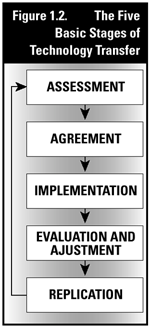1.6 The Innovation System and Pathways: A Framework for Analysis
 |
| Figure 1.1: The Technology Transfer/Innovation System. |
The theme of technology transfer is highly interdisciplinary and has been approached
from a variety of perspectives, including: business, law, finance, microeconomics,
international trade, international political economy, the environment, geography,
anthropology, education, communication, and labour studies. Although there are
numerous frameworks and models put forth to cover different aspects of technology
transfer, there are no corresponding overarching theories (Martinot et al.,
1997; Reddy and Zhao, 1990). This Report employs the technology transfer/innovation
system as a framework for analysis. In this system (see Figure 1.1),
technology is transferred as knowledge, money (investment)
and goods (trade) flow among different stakeholders: governments, private-sector
entities, financial institutions, non-governmental organisations, and research/teaching
institutions. Innovation performance depends on the way in which the different
stakeholders of the "innovation system" - businesses, universities
and other research bodies - interact with one another at the local, national
and international levels. It also depends on the innovation promotion policies
of governments.
There are a large number of pathways through which the various stakeholders
can interact to transfer technologies. The most common include:
- direct purchases
- licensing
- franchising
- foreign direct investment
- sale of turn-key plants
- joint ventures
- subcontracting
- cooperative research arrangements and co-production agreements
- export of products and capital goods
- exchange of scientific and technical personnel
- science and technology conferences, trade shows and exhibits
- education and training (of nationals and foreigners)
- commercial visits
- open literature (journals, magazines, books, and articles)
- government assistance programmes.
Other pathways require little or no interaction among the principal stakeholders,
because they involve the acquisition of technology without the consent of the
provider. Among these are:
- industrial espionage
- end-user or third country diversions
- reverse engineering.
Each pathway represents different types of flows of knowledge, money, goods
and services among different sets of stakeholders (see also Annex 1-3). Each
pathway has very different implications for the learning that occurs and ultimately
the degree of technology-as-knowledge transfer that takes place beyond simple
hardware transfers.
The following framework classifies pathways into three primary types:
- Government-driven pathways are technology transfers initiated by government
to fulfil specific policy objectives;
- Private-sector-driven pathways primarily involve transfers between commercially
oriented private-sector entities, and have become the dominant mode of technology
transfer;
- Community-driven pathways are those technology transfers involving community
organisations with a high degree of collective decision-making.

|
|
Figure 1.2: The Five Basic Stages of Technology Tansfer.
|
Some observers have suggested that along any pathway, technology transfer follows
five "stages": assessment (including identification of needs), agreement,
implementation, evaluation and adjustment, and replication (Figure 1.2). The
stakeholders involved and the specific decisions and actions taken at each stage
differ greatly depending upon the pathway. By analysing the interests and influences
of different stakeholders at each stage it is possible to determine how various
barriers to technology transfer might be overcome.
Much has been written about why multinational corporations choose one pathway
over another. Some of the key issues are summarised in Table 1.2. While wholly
owned subsidiaries have been the dominant modes of foreign direct investment
(except where joint ventures have been specifically targeted by national policies,
such as in India), international joint ventures have been growing in number
since the 1980s. Various theories have been advanced to explain this change.
Datta (1988) suggests that: (a) host governments are increasingly requiring
foreign investors to form joint ventures, (b) multinational corporations have
realised that the knowledge of complex and often volatile local business environments
by local partners can be a significant asset, and (c) there is a growing trend
to internationalise business to reduce costs. Contractor (1991) sees transaction
costs as determinants of a firm's choice of the mode of transfer. Kogut (1988)
explains joint ventures in terms of transaction costs, strategic behaviour,
and transfer of organisational knowledge and learning. Kogut further suggests
that some forms of tacit knowledge can only be transferred through a joint venture,
because the knowledge is organisationally embedded and not conducive to licensing
or other forms of transfer. On the other hand, increasing global competition
may deter technology transfer, especially at the cutting edge.
| Table 1.2 Key issues and factors
affecting choice of technology transfer pathways |
| PATHWAY |
KEY ISSUES AND FACTORS AFFECTING CHOICE OF PATHWAY |
| Direct sales |
Import duties
Advertising
Product compatibility
Standards and certification
After-sales service and training
Distributor capabilities
Degree of system integration required before use by final user
Insurance and product liabilities |
| Turnkey contracts |
Domestic technological capabilities
International competitive bidding
Import duties
Buyer training
Corruption |
| Wholly owned subsidiaries |
Acceptable financial risks
Foreign investment policies of government
Expected size of domestic market
Export duties
Repatriation of profits |
| Joint ventures |
Acceptable financial risks
Ensuring protection of intellectual property
Expected size of domestic market
Product adaptation
Partner identification, appraisal, and negotiations
Foreign investment policies of government
Export duties
Repatriation of profits |
| Licensing agreements |
Intellectual property protection
Future domestic market and strategic interests of MNC
Acceptable financial risk |
| Multilateral development lending |
Need for and viability of carrying out structural economic reforms
Guarantees and credit worthiness of government and borrowers
Economic and financial rates of return from investments
Procurement procedures |
| Development aid and other grant financing (like GEF) |
Donor country political agenda
Multilateral agency priorities
Recipient country capacity to make informed choices
Range of stakeholders' involvement in recipient country |
| Twinning, conferences, symposia, and other person-to-person pathways |
Ability to attend conferences, symposia
Availability of counterpart resources
Access to information and communication means
Intellectual property protection |
|